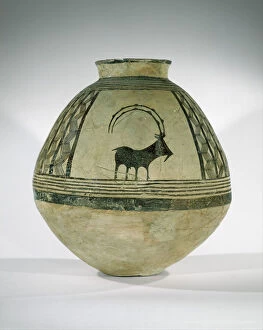Early Bronze Age Collection
The Early Bronze Age, spanning from 2600-2400 BCE, was a period of significant cultural and artistic development
All Professionally Made to Order for Quick Shipping
The Early Bronze Age, spanning from 2600-2400 BCE, was a period of significant cultural and artistic development. This can be seen in the exquisite craftsmanship of various artifacts that have been discovered from this era. One such artifact is the Statuette of a Female Figure. Created by an unknown artist, this sculpture showcases the skill and attention to detail prevalent during this time. The delicate features and graceful pose of the figure reflect the artistic sensibilities of the Early Bronze Age. Another remarkable find is the Storage jar decorated with mountain goats. Dating back to around 3800-3700 BC, this painted ceramic jar provides insight into both daily life and artistic expression during this period. The depiction of mountain goats on its surface suggests a connection between humans and nature, highlighting their reliance on animals for sustenance. A particularly intriguing piece is "The Stargazer, " a statuette of a woman carved from marble around 3000 BC. This unique artwork portrays a woman looking upwards towards the heavens, symbolizing her fascination with celestial bodies or perhaps indicating religious beliefs associated with astrology or astronomy. The Solar Disc found in Alacahoyuk, Turkey further demonstrates early civilizations' interest in celestial phenomena. This disc may have served as an important religious or ceremonial object related to sun worship or solar deities. Archaeological discoveries also shed light on burial practices during this era. The Crouched Burial in Round Tumulus on Dunstable Downs depicts how individuals were interred within mounds surrounded by earthworks for protection and commemoration purposes. Medical practices are evidenced through findings like trepanned skulls – ancient evidence suggesting attempts at surgical intervention for head injuries or illnesses. In terms of luxury items, The Rillaton Gold Cup stands out as an impressive example from Early Bronze Age Britain (1700-1500BC). Its intricate design reflects advanced metalworking techniques employed during that time period. Animal figures were also prominent in Early Bronze Age art.








